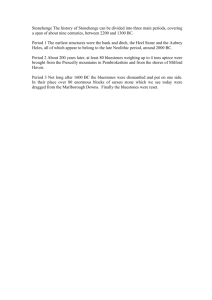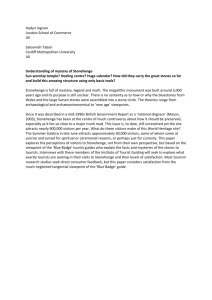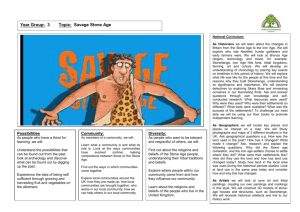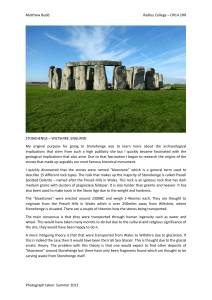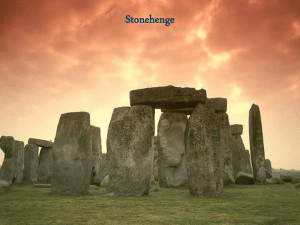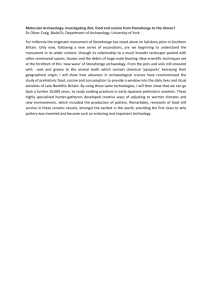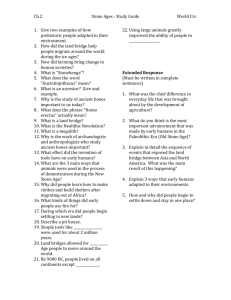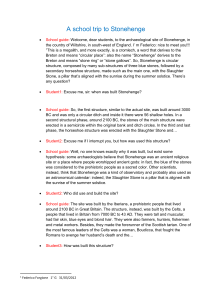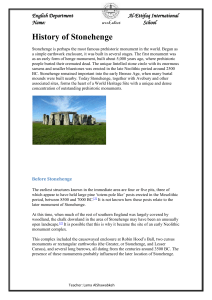Stonehenge & Sky Burial
advertisement
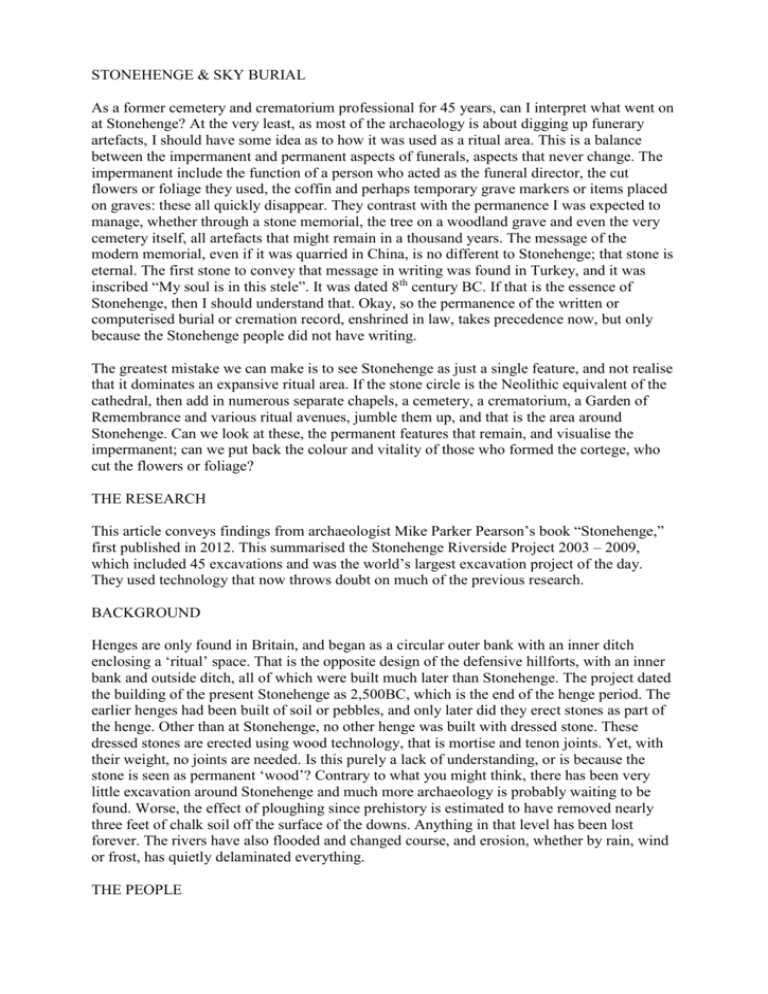
STONEHENGE & SKY BURIAL As a former cemetery and crematorium professional for 45 years, can I interpret what went on at Stonehenge? At the very least, as most of the archaeology is about digging up funerary artefacts, I should have some idea as to how it was used as a ritual area. This is a balance between the impermanent and permanent aspects of funerals, aspects that never change. The impermanent include the function of a person who acted as the funeral director, the cut flowers or foliage they used, the coffin and perhaps temporary grave markers or items placed on graves: these all quickly disappear. They contrast with the permanence I was expected to manage, whether through a stone memorial, the tree on a woodland grave and even the very cemetery itself, all artefacts that might remain in a thousand years. The message of the modern memorial, even if it was quarried in China, is no different to Stonehenge; that stone is eternal. The first stone to convey that message in writing was found in Turkey, and it was inscribed “My soul is in this stele”. It was dated 8th century BC. If that is the essence of Stonehenge, then I should understand that. Okay, so the permanence of the written or computerised burial or cremation record, enshrined in law, takes precedence now, but only because the Stonehenge people did not have writing. The greatest mistake we can make is to see Stonehenge as just a single feature, and not realise that it dominates an expansive ritual area. If the stone circle is the Neolithic equivalent of the cathedral, then add in numerous separate chapels, a cemetery, a crematorium, a Garden of Remembrance and various ritual avenues, jumble them up, and that is the area around Stonehenge. Can we look at these, the permanent features that remain, and visualise the impermanent; can we put back the colour and vitality of those who formed the cortege, who cut the flowers or foliage? THE RESEARCH This article conveys findings from archaeologist Mike Parker Pearson’s book “Stonehenge,” first published in 2012. This summarised the Stonehenge Riverside Project 2003 – 2009, which included 45 excavations and was the world’s largest excavation project of the day. They used technology that now throws doubt on much of the previous research. BACKGROUND Henges are only found in Britain, and began as a circular outer bank with an inner ditch enclosing a ‘ritual’ space. That is the opposite design of the defensive hillforts, with an inner bank and outside ditch, all of which were built much later than Stonehenge. The project dated the building of the present Stonehenge as 2,500BC, which is the end of the henge period. The earlier henges had been built of soil or pebbles, and only later did they erect stones as part of the henge. Other than at Stonehenge, no other henge was built with dressed stone. These dressed stones are erected using wood technology, that is mortise and tenon joints. Yet, with their weight, no joints are needed. Is this purely a lack of understanding, or is because the stone is seen as permanent ‘wood’? Contrary to what you might think, there has been very little excavation around Stonehenge and much more archaeology is probably waiting to be found. Worse, the effect of ploughing since prehistory is estimated to have removed nearly three feet of chalk soil off the surface of the downs. Anything in that level has been lost forever. The rivers have also flooded and changed course, and erosion, whether by rain, wind or frost, has quietly delaminated everything. THE PEOPLE Take yourself back and try to read the landscape the way prehistoric people used it, a technique called phenomenology. It is 8,000 – 2,500BC, a period in which we changed from hunter gatherers to tribal communities, the Mesolithic and Neolithic periods. That is before the Copper, Bronze and Iron Age, and the Romans. Ignore the tumuli, bell barrows and hillforts, as all came after this period. Metal was unknown (in Britain) and the people lived in scattered hamlets, not villages or towns, and used flint and stone tools. In the Neolithic period, a riverine culture developed using the River Avon as its access ‘road’, from Christchurch on the coast, to beyond Stonehenge. The coast and River Avon meadows were bountiful in fish and waterfowl. Experts consider that salmon and huge sturgeon used to ‘run’ the river each year, and were easily caught. The flood plain reeds provided winter forage for cattle as well as hut roofing material. There was more rich land than could be used, and the local people, now called the Durotriges, flourished, and created a ‘surplus’ which clearly enabled them to manage large scale communal projects. At first, in 4,000BC, the same period in which cattle first appeared in Britain, it was focussed on building large chambered tombs, then, in 3,700BC, they built causewayed enclosures, which are usually banked and ditched circles broken by paths, or causeways, leading inside. No pattern exists and one causeway or perhaps up to five, broke the circle. Nobody knows what happened in the flat, central ritual space but they are often called gathering places. That is also the period when a number of cursus were created, two of these being just north of Stonehenge. The name incorrectly reflects the Victorian view that these resembled Roman chariot racing circuits. Finally, the people moved on to building stone circles in around 3,000BC. The Riverside Project proved that in building Stonehenge, people assembled in large numbers from all over the UK. Movement over the country was already commonplace if we use the trade in stone axes as an example. Kinship appears strong, and the age was relatively peaceful, as few fortifications are found from this period. The fortifications began, perhaps fifteen hundred years later, with hill forts and coincidentally, after metal, including gold, came into tribal possession. These hunter gatherers came into Britain after the ice age, but we have no idea where they came from, with a simple crossing from what is now France probably the strongest theory. Or did they walk in across the boggy Doggerlands, which then linked eastern Britain and Northern Europe, before the area flooded and created the North Sea. Other experts consider the people moved up the coast from Spain and Portugal, and others, that they moved down from Orkney. Certainly, in Orkney they were building stone houses and circles earlier than in the south. Whatever, if we use Stonehenge and the wealth of monuments as evidence of success, then perhaps this area was the cradle of civilisation in Britain. Many of us alive today are directly related to these people. RELIGION & BELIEF First of all, forget the Druids! They did not exist in the Neolithic period and never had any involvement with Stonehenge. In truth, we have virtually no idea what religion or beliefs existed at that time. A few phallus type carvings and odd pottery items have been found, but they convey little. No writing or paintings exist and stone markings, such as they are, convey little. Yet it is evident that these people saw themselves as the elect in some way, because life was good if children were raised and human numbers increased. All that is clear is that the most significant rituals revolved around sunrise and sunset in midsummer and midwinter. What many do not realise is that Stonehenge is the only certain stone circle in Britain that is aligned to the solstices. Avebury, otherwise such an impressive stone circle, does not align. Nothing in Europe aligns, which is why Stonehenge is unique. Was that just a matter of measuring the seasons, or was the sun a God? Certainly, in the early Neolithic period, farming was new, and crops do not appear significant, so ‘harvest’ thanksgivings do not appear relevant. What is also evident is that change was a constant, as remarkable new ritual settings were developed and current ones were modified. For instance, wood circles, where tree trunks were stood upright rather than stones, were in vogue for perhaps 200 years, say 3,200BC, and began with two circles of timber and some increased to six. A person stood in the centre of such circles would be surrounded by a mass of trunks and, perhaps, unable to see out. We have the postholes to prove this, but were there lintels on the posts? Using Stonehenge as our guide, it appears likely, so were these carved, or lined with skulls and bones in some way? Were some of the wood circles roofed? We shall never know. Whatever, a question we might consider is why single skulls, parts of skulls and single large bones are found scattered about sites. Even when graves are excavated, complete skeletons are, throughout the 5,500 years in question, very rare, perhaps unknown. What is also evident is that stone tools were greatly prized, with polished stone axes and maces in use, but often completely unworn when excavated. They were clearly ceremonial, and some were made of Alpine stone, though most came from Wales and the Lake District. The latter were quarried in Langdale from a known outcrop of green Silurian stone. Flint axes, daggers and knives were utility tools but these do not appear to have been so prized, or treated as ritual items. Sometimes, where stone tools were buried with a body, they may have been ancient themselves, perhaps many hundreds of years old, and so prized for their age. Such tools cannot be dated, of course, so their age is always in doubt. Experts on this period often discuss ceremony and ritual but appear to discount events which we might refer to as kingmaking. There were no regal crowns or gold torques in this period, and one Irish expert on television recently referred to these early ceremonies as ‘inaugurations’, a ritual that conveyed status to an individual. He stated that they took place on significant hilltops which appears unlikely, as if open space had ceremonial or ritual value, then why build Stonehenge, henges or causewayed enclosures throughout the country? The Stonehenge area has three significant features: Stonehenge, the cursus and Durrington Walls, so let’s consider each of these in turn. STONEHENGE It is essential to put Stonehenge into perspective. What we see today is the culmination of perhaps 5,000 years of ritual on that site before the present stones were erected. We will refer to the present Stonehenge as the sarsen circle, for reasons which will become obvious. Stonehenge, as a sacred area, is far older than initially thought. For instance, when the visitor car park was built in 1966, three postholes were found. The wood was pine, not a common local timber at that time, and they were erected, perhaps carved, as totem poles, in 8,820 – 7730BC, around 5,000 years earlier than the sarsen circle. As Mesolithic hunter gatherers never built monuments anywhere in Europe, this is an anomaly. Consider also that recent ground surface searches around Stonehenge found 80,000 worked flints but only one was part of a broken flint axe. Previous UK data suggests that 60 axes should have been found in this number, so this is a further anomaly. These flint finds, extrapolated through experience, suggests that 51 million pieces of worked flint exist on the site, far more than, say, at Avebury. There are also fifteen long barrows in existence around Stonehenge and not one has been investigated in modern times. The fact is, we know little and much, probably, remains to be found. The most noticeable structure that we see at Stonehenge today is a circle of upright sarsens with some surviving horizontal lintels perched on top of them. The sarsens are large slabs of sandstone-like rock that were almost certainly hauled 25 miles from the Avebury area. Other parts of the circle are composed of bluestones, which are smaller stones of dolerite and other geologies that originated in West Wales. The media prefers the theory that the bluestones were rafted along the Welsh coast, across the Severn Estuary and up the River Avon at Bristol, and then hauled 20 miles over the downs to Stonehenge. The lintelled sarsen outer circle encloses a circle of these smaller bluestones. Inside these are the five sarsen trilithons, the largest stones by far. A trilithon is a pair of upright stones with a lintel joining them. One upright trilithon is 10 metres long and weighs 35 tons. The trilithons form a horseshoe, perhaps a sanctuary, facing and perhaps intended to ritually ‘capture’ the rising sun. Some experts suggest that the trilithon footprint is similar to some buildings used by the Neolithic people, the purpose of which we do not understand. Inside the trilithons is another circle of bluestones, in truth, more a double arc, the points of which also mark the sun rise, to the east, and setting, to the west. There are 82 sarsens, and although symmetrical above ground they are often awkwardly shaped underneath, which is why many fall over. They were dressed lying on the ground, then erected, and the underside then dressed, but only up to head height. It appears that they did not have ladders. The sarsens were dressed north of Stonehenge and a 5 x 5 metre square was opened in this area during the project and 6,500 chippings were found together with 50 hammerstones. Some of the stones of these various structures have fallen down, others have been broken up and taken away, and several have been re-erected since the seventeenth century. The pattern for the sarsen circle and trilithons is often said to be inspired by Egyptian practice, or even by aliens. The reality is that, in 3,650BC, the entrance to West Kennet burial chamber, near Avebury, was built with two upright sarsens supporting a massive lintel slab, so this technology was understood. The sarsen circle is about 30 metres in diameter, but it sits at the centre of a much larger circle, about 100 metres across, formed by the bank and ditch of an earthen enclosure. This was the original bluestone circle. The bluestones of the original outer circle may be the key to Stonehenge. In all, about 80 bluestones have been used over the entire site and 43 now remain. What the Riverside Project has proved is that Stonehenge began as this stone circle, around 3,000 – 2,920BC, comprising of 56 bluestones sitting on cremated remains, and built almost 500 years before the sarsen circle was created. It was entered or exited at the Heel Stone, a natural sarsen erected to lead the eye east, to the sunrise. The surprise, perhaps, is that archaeologist Mike Parker Pearson referred to this circle as the Chieftains Cemetery. He counted 63 bodies, all cremated, mostly identified through small ear bones. Some of the bodies were women and children, and if these were double or triple funerals, as it were, it may be that precisely 56 inhumations (funerals!) took place under the 56 bluestones. The remains were originally placed beneath each stone, and crushed into the chalk that formed the socket. The burials took place over 200 years, from 3,000 BC to 2,800 BC. The only grave goods found were one mace head, which implied a warrior, and an ‘incense burner’, which implied a religious leader or shaman. But the presence of women and children’s bones denied the circle as a warrior or religious burial area, as women did not participate in either, as far as we know. Mike Parker Pearson’s conclusion was that they were an elite, perhaps an aristocracy. This is unprecedented, as no such burial areas exist elsewhere in the UK. It also overturns decades of archaeologists adamant that Stonehenge was not a cemetery. Stone circles and henges generally are not cemeteries and were not routinely used for cremation or burial. The odd grave exists but there is no pattern. In Cumbria, human cremated remains have been found up against, or under, the individual stones in circles. These appear to be dedication burials, a form of ritual probably intended to commemorate placing the stone into a prepared socket in the ground. We might ask pertinent questions about the completion of this bluestone circle. Fifty six bluestones could not be brought from West Wales in one batch. It must be assumed that men fetched the stones in small numbers when they were least employed in food production, which suggests autumn and winter. If four stones were fetched each trip, it would take 14 years. Did they wait until all the stones were available and then complete the circle, and subsequently remove stones to put the cremated remains underneath? Or did they bring in the bluestones as and when the ‘chieftains’ died, taking 200 years to complete the circle? A quarter or half stone circle would be a poor ritual space, and does not sound feasible. An important finding in this project is the existence of a second bluestone circle at the end of the avenue from Stonehenge to the River Avon. This was constructed using 25 stones, and although the dating is inconclusive, a flint arrow found suggests the same period as the Stonehenge bluestone circle. There were no chippings so the stones were not dressed in this location, unlike with the Stonehenge bluestone circle. A feature of all bluestone excavations is that an antler pick, ideal for dating, is never left in their sockets. Yet such ‘placements’ were routine in ditches and around some sarsens, where the abandoned picks were rarely worn out. The ritual importance of this second circle is its riverside location. Upon disembarking from a boat (dugout), a person could walk immediately into the bluestone circle. From the centre of this circle, the ritual walk is north on the avenue to Stonehenge, with a left turn to the west just before the dead straight 450 metre stretch to Stonehenge, entering at the Heel Stone. The avenue itself is a mile long, 22 metres wide, with a (later) bank and external ditch on either side, but little can now be seen. The straight section of the Avenue from Stonehenge exactly follows three parallel natural chalk ridges, which always marked the sunrise from Stonehenge. Some consider that this is the reason why Stonehenge is where it is; that the Gods put in place this natural feature marking the sunrise. The bluestones in the riverside circle were removed around 2,400BC. Were they placed inside the sarsen circle as part of the rebuilding at Stonehenge, or did they go somewhere unknown? A further question is, why the bluestones? No other circle used them so why at Stonehenge? The stone comes from the north Preseli hills, 140 miles west-northwest of Stonehenge. The altar stone, a one off, weighs 8-10 tons, but most of the stones are about 4 tons in weight. In 2,000, as part of the Millennium celebrations, a group of enthusiasts slung a Preseli bluestone between two boats and sailed out of Milford Haven – four miles out, it slid into the sea! Most archaeologists now prefer the theory that they were moved overland, from one community to another. That suggests that the movement was constant, and with 50 men per stone, about 4,000 men could move all the stones over some years. They still had to cross the Severn Estuary, of course. The reason why they chose stone from Preseli is unknown. One theory is that this area is rich in early stone age tombs, as is South Wales generally, but it is weak in later Stone Age evidence. As stock farming became more important, did the people migrate from their hunter gatherer lands in Wales, perhaps moving to the richer grazing in the south of England? Subsequently, they might return to quarry bluestone, as the mystical stone of their forefathers. No evidence is found to suggest that the bluestones had healing powers, which is often assumed. In 2012, a Neolithic quarry was found in the Preseli Hills, with a partly prepared bluestone found beneath ground, and with quarry workers huts in the vicinity. More research is to be carried out in this area. In considering the later rebuild at Stonehenge, it will be noted that the outer sarsen circle encloses a bluestone circle which encloses the sarsen trilithons, inside of which is the bluestone arc. Is the mix of the two stone types meaningful? The bluestones might represent the homeland, the landing place of the hunter gatherers on the Welsh coast. The sarsens might reflect Avebury, part of the new farming lands, in which the people ultimately flourished. The circle brings all these elements together, unifies the whole. This also raises a further conundrum. The total number of sarsens is 82, but that hides the fact that at least two were naturally occurring stones in the Stonehenge area. If the true number of sarsens hauled from the Avebury area is eighty, which matches the eighty bluestones, is that coincidence, or not? At the very least, the choice of sarsens suggests that the people of Stonehenge and those at Avebury were friendly and working together. That contrasts with author Bernard Cornwall’s view in his novel ‘Stonehenge’ in which he has the two tribes in conflict, and building their respective circles in competition with each other. If united, then this supports some views about the most likely route chosen to move the sarsens to Stonehenge. It appears logical, to avoid wet and low ground, to move the stones from Marlborough Downs, to Avebury, and then across to the small village of Marden, where a massive henge is now known to have existed, and from there to Stonehenge. It may well be that this was an ancient high level route between the two areas and that it already possessed a ritualistic significance. A feature noted about Stonehenge is that through the ages, an area of about one mile, with the circle at its centre, was generally undisturbed. No farming was done or dwellings erected, neither has a builders camp been found. Even hundreds of years later, the land was seemingly sacred, and avoided for farming. This research suggests that Stonehenge, and perhaps most circles, were created far more quickly than was previously thought. That relies on an ability to organise a large workforce, particularly when the larger circles were created. What is also evident is that henges and stone circles followed trends. It is an inimitable human tendency to be in vogue so it can be reliably assumed that every 50 or 100 years, the standard pattern was changed to some degree. Indeed, it is known that hundreds of postholes exist in Stonehenge and not a single one can be dated. Stonehenge was clearly envisaged as the most complex stone circle, the epitome of the stone builders art, and yet was also the epitaph for such creations. It was probably the last stone circle ever built, required the greatest ever work input, was built within a mere 40 years and was then abandoned. THE CURSUS A short distance north of Stonehenge lies the greater cursus, and beyond that, the lesser cursus. Ignoring the latter, the greater cursus can be seen from Stonehenge. It comprises of two parallel banks and ditches, on an east – west orientation and is 1.75 miles long. From either end, the opposite end is over the horizon and cannot be seen. At each end, and transverse, is a long barrow but only a few human and animal bones were excavated. Huge human effort was necessary to create these features, yet neither cursus has an entrance or exit in its bank and ditch, and nothing indicative has been located inside. Some experts consider that they are a ceremonial way, perhaps marking an ancient trackway, but it is an assumption that appears weak. Both cursus are dated 3,660 – 3370BC which pre-dates both the bluestone and sarsen circles. What is evident is that the cursus bank and ditch, and the long barrow at each end, were coated in fresh chalk. They were glaring white, as were the ditches and banks around the Stonehenge bluestone circle and the avenue. Consider also that Silbury Hill, built some years later near Avebury, was also covered in bare white chalk. It must have looked like a white pyramid. Was this whiteness, this ‘purity’, which is unique to chalk downs, a reason why the area was so significant? It also begs a question that I have not seen answered. Was the Stonehenge sarsen circle also coated in chalk daub? If so, it would have been very impressive, and very obvious to those looking from afar. DURRINGTON WALLS Less than two miles east of Stonehenge is Durrington Walls, which the Riverside Project proved to be the largest Neolithic encampment in Europe, and the builder’s camp when the sarsen Stonehenge was built. It was later henged and hut excavations suggest that anywhere between 2,000 and 4,000 people lived inside. The camp is reliably dated, by antler finds, to 2500 -2460BC, a period of just 40 years. What was found suggests that this camp was inhabited for only short periods each year. The remains of domestic pigs were found, killed by arrows, even shot into the legs and feet. No suckling or young animals were found, so the pigs were not reared at Durrington. Over 175 cattle bones were put through isotopic tests and few of the animals were raised on chalk, even though the chalk extends for 20 miles in all directions. The cattle were also from different herds, and some were from the West Country, Wales and Scotland. It appears that all these animals were used for feasting, possibly when the work parties finished each year. Perhaps the work was finished in late December to accord with the winter solstice. All this implies that for 40 years, at least 2,000 people met each autumn at Durrington Walls. The annual job was, say, to haul two sarsens from near Avebury, to Stonehenge, dress them on site, and erect them. The masons waste, dressed stone chips, are routinely found strewn over the ground north of Stonehenge. This reminds me that even today, some cowboy masons leave their stone and cement waste in cemeteries after erecting memorials. The wood circles at Durrington are another enigma. One, called Woodhenge, with it’s posts marked out by modern concrete stumps, stands outside and south of Durrington Walls. Two wood circles were also erected inside Durrington Walls. All appear to date exactly for the period when Stonehenge was remodelled with the sarsens, and one of these is fascinating because the position of the wood posts precisely replicates sarsen Stonehenge. Was it the builder’s model for Stonehenge? Whereas people did not want to, or were prevented, from living near Stonehenge, it appears they were content to live clustered around and close to the wood circles. That suggests that wood circles were associated with different rituals, perhaps those of the living rather than the dead. WHERE ARE ALL THE BODIES? Much of the archaeology relates to what happened to the dead, which is a seriously flawed approach. Even assuming a small population around Stonehenge of, say, 500 people, over a period of 1,000 years we can anticipate a total of around 12,000 deaths. As we have located perhaps 1% of these deaths, 99% are missing. No cemeteries have been found so where are the bodies? As mentioned previously, around 4,000 BC they built the chambered tombs, with similar tombs built in Europe and right up to Orkney. Early assumptions were that bodies were placed in the chamber and allowed to decompose, and the remaining bones then used in some way, or put in rivers. What appears obvious is that there are too few chambers to accommodate the number of deaths. Secondly, catacombs, which is effectively what they are, are fine in hot countries with low rainfall, where bodies dehydrate rapidly, but not in our wet climate. The chambered tombs are small, and damp, and in winter decomposition would lead to a mass of body fluid soaking into the floor. As most bodies were children, with few hard bones, the amount of decomposing tissue would be considerable. Within decades, this organic ooze would make walking in the tomb hazardous, flies would proliferate, and the smell would be nauseating. To avoid this, a solution might be to place only bones in the chambers, so how could this have been managed? On the banks of the River Avon just below Woodhenge, project excavations found three sets of postholes, each of four posts forming a square, the whole surrounded by a palisade, a fence of posts driven into the ground. The biggest posts in the squares were 50 centimetres across, and estimated at over 5 metres high. The conclusion is that they were towers, looking out over the river, and presumed to be holding platforms. Each palisade entrance was orientated to midwinter solstice sunrise. The assumption – sky towers! This is not such a surprise because there have been suggestions that the earlier causewayed enclosures, a ritual space inside a bank and ditch, could have been designed to expose bodies to birds or animals. Perhaps they progressed to towers as they created more efficient flint axes to cut timber, or perhaps they did not want animals feeding on the body rather than birds. Is it too radical a suggestion, truly a flight of fancy, to consider sky towers in this country? If you think so, consider that in Tibet, where sky burial may have persisted from the Stone Age, they consider the vulture a form of angel and the birds are venerated. This fact reminds me that I have avidly watched decades of excavations at Stone Age sites with Time Team, and read much, all of which confirms that the bones of most mammals are found, yet no bird bones. Are these essentially lightweight bones less enduring, or was it that people did not consume the myriad of geese and swans available in winter because birds and humans had a spiritual association? If that was because of sky burial, then eagles, buzzards, kites, ravens and carrion crows could have fed on the bodies, and probably European vultures, at least in summer. Even in 2013 over one hundred sitings of vultures were made over the south of Britain. It is evident that the larger eagles and vultures swallow small fleshed bones so feet, hands and ribs would disappear as well as all the soft tissue. That would fit with the overall finding that full skeletons are never found from this period and disarticulated skulls and large bones are found scattered about sites. We can imagine the human body as the perfect bird feeder, with nature creating a grisly race; which gets us first, the birds or the blowflies, or do they work together? Once the bones were cleaned off, which perhaps was believed to release the spirit, the bones could be deposited in the river, which itself seems to have possessed a sacred element. Sky burial is also faster even than modern cremation based on an incident when a female walker in the Pyrenees fell to her death in 2013. Two friends, walking with her, called the police and they took 50 minutes to locate her body. Initially they could not see the body from their helicopter until they realised that it was covered by gorging Griffon Vultures. By the time they got to her the birds had stripped her body of all flesh and only a few bones remained. She was clothed so that had slowed the process to some degree. It might be assumed that this woman, a mountain walker, was fit and well, and not on any medication. This reflects the fact that vultures appear to reject bodies contaminated with drugs and medicines. Typically, that is all British bodies in view of the kind of death we now experience. What is also evident is that sometime between 4,000 – 3,000BC, the use of the chambered tombs ceased, or at least was infrequent, and cremation/burial began. The project used the term cremation/burial to suggest that the cremation and burial were integrated; that the word cremation on its own is not sufficient. Was this a progressive change, or did other methods occur in between? Or was cremation/burial only allowed for chieftains or others of rank because the cremation pyre demands a massive labour input? Again, that sounds remarkably similar to the situation in Tibet and Mongolia, where cremation is reserved for high lamas and dignitaries, and where the common people use sky burial. The reason, it is said, is because all ground is rocky, or frozen, and wood is rare. Consider also that sky burial and cremation are similar in that both remove the flesh, free the spirit, and leave the bones. Charcoal found with cremated remains suggests that the pyres were built up using hazel, and other small easily cut timber. Hazel re-grows the moment it is cut, and if coppicing was understood, a regular supply for the small numbers of cremations involved, was perhaps sustainable. But the Wiltshire chalk downs were never heavily wooded and were principally down to grass, so bringing in the wood must have been onerous. As today in India, only those who can pay for the wood are able to be cremated. A Neolithic pyre, necessarily composed of thin wood, which was also damp as they had no covers, would attain a relatively low temperature and fall far short of the 1100C of a modern cremator. The skin and outer surface of the body is easily cremated but the muscle tissue, especially that of younger bodies, more so males, is dense and difficult to break down. The timber will also burn quickly and the body then tends to drop into the embers. That assumes the fire is well managed because if one side burns out, the heavy body can easily topple and be thrown off the fire. Once the body is in the embers, oxygen is denied and there is none of the volatility of the modern gas jet. Hence the dense flesh just smoulders over a long period. Today, in India, an untouchable sits beside this smouldering tissue, feeding fresh kindling under the resilient bits because few families can afford the cost of a huge pyre. What remained of the Neolithic flesh could then have been scraped off the bones with a flint. Crematoria professionals are aware that bones are calcined (oxidised) in a modern cremator and we know them to be quite easily broken-up. Is this the case with pyre cremations, or not? I doubt it and one could imagine the bones remaining hard and complete, very organic and perhaps still containing marrow so subject to theft by dogs, foxes, and probably wolves and bears at that time. Consequently, a vigil must be held by the fire, and when cool enough, the bones removed by hand. Even today, many cultures are quite content to remove only the larger bones and ignore the smaller, and perhaps this was the practice in the Neolithic Age. Archaeologists usually find one kilo of cremated bone, which is about half of the expected weight. Was the bone left in the wood ash, or were the bones divided in some way? Based on modern cremation experience, about two kilos of bone ash would be expected if coffin ash is discounted. Although Neolithic people were smaller than us and presumably lighter in weight, this might be compensated for by their bone density. Due to heavy labour, walking, even running, their bone density would be very high, the opposite of modern people experiencing an epidemic of osteoporosis. As the ashes the archaeologists now excavate are often broken into small fragments, was this a ritual carried out by hand, perhaps by select people using ceremonial stone tools? The deposits of human ashes are occasionally found in pockets in chalk, which suggests that they were contained in a leather bag, or birch bark box or similar container. The ritual purpose behind cremation demands some consideration. Some experts will suggest that Stone Age cremation might have been generated by Sun God worship, which supports the use of fire. Unlike in Egypt, no inscription or pottery figures to support this have been found, neither are other British circles orientated to the sun. Or was cremation a means of purifying the dead. If so, it is unlikely that the integrated interment of the ashes, and effectively depurifying them, has any merit. Then there is the theory that cremation is a sacrifice, perhaps related to fertility rites, and the ashes were then scattered on fields. The fact that no bone fragments are found in soil disputes this theory. My theory would suggest that the cremation is purely utilitarian, a means of reducing a large body to a small, peripatetic, pile of bones. This enables them to place the remains under a stone, which is not possible with a body. The historical logic here is that, as hitherto hunter gatherers, and with deaths potentially occurring over a wide area, they could immediately expose a body to birds and/or animals, and then carry the bones of the dead with them until they returned to a known homeland burial chamber or river deposit site. Otherwise, burials would be scattered over a wide home range. Neither does burial have anything to commend it. Digging was laborious and the fact that any body burial, necessarily shallow when using antler picks, would be dug up by the many foraging wolves and bears, makes it rather pointless. Consider also that today many people choose cremation because they want to scatter the ashes at some meaningful place, or take them back to an old family grave, in the homeland, perhaps where their parents were interred. Human needs do not change! A final point, in cases where a full body is to be carried to a place of burial or cremation, is the fact that many old cultures insisted that a body had to be disorientated on its way from the living zone to the dead. This was to ensure that the spirit could not find its way back to the living people, and trouble them. Is that why they incorporated a sharp bend into the Stonehenge Avenue? As the person who introduced natural burial, I found this research fascinating. Often, people take some pleasure in telling me that my idea was effectively stolen from the ancients. What is evident here is that nobody was interred under or near trees, and no environmental ritual, as such, is evident in the past 10,000 years. THE RIVER AVON The importance of the river to Neolithic people cannot be overemphasised, and the archaeologists were aware of this as part of the project. The River Avon, where it passes south of Stonehenge, was six times wider and three times deeper than it is now. It had utility value as a means of moving around, but did it also have spiritual value? Excavation now proves that where the river abutted Durrington Walls henge, an avenue ran from the camp down to the river. It was 30 metres wide, with banks and standing stones down each side, and a central road 15 metres wide, covered in packed flint. The avenue orientated between sunrise and sunset. Embarking from this ritual space, on a boat, a two mile drift downstream drew up beside the bluestone circle on the right bank – the ceremonial entrance to the one mile long Stonehenge Avenue. Is this just coincidence, a matter of utility in using the river, or was the entire route planned? Are, or were there, other ceremonial features along the river heading down to the coast at Christchurch. None have been found and the river has moved due to flooding, and much has been scoured out. Opportunities to excavate by the River Avon are rare, but two gardens have been investigated just north of Amesbury at the request of the householders. Each garden contained 4 x 1metre deep pits, filled with charcoal, two with 500 worked flints in them, and all of them full of cattle or pig bones, one with a brown bear scapula and two, one in each garden, with a scallop shell from the coast. All were single deposits, say from a feast, and dated to 2,600BC. It was hard work, digging such pits with an antler pick, so why! How many such pits exist? Had they been cremation pyres, human bone would have been found, but none arose. Were the pits simply the remains of riverside barbies, or was there more to the river than we will ever know? THE DOMAIN OF THE LIVING VERSES THE DOMAIN OF THE DEAD Mike Parker Pearson’s rather simplistic conclusion is that Durrington Walls was the place of the living, and Stonehenge the place of the dead. It is a poetic Arthurian vision suited to Tennyson’s ‘Idyll of the Kings’, where King Arthur’s body is drawn onto a barge by maidens in diaphanous white gowns, and the barge eases towards the sunset and Avalon. Mike’s vision sees the dead prepared at Durrington Walls, a cortege carries the body down the flint surfaced avenue and placed on a boat. This drifts two miles down the sacred River Avon and berths at the end of the Stonehenge Avenue, where the body is carried into the centre of the bluestone circle. Something akin to a blessing occurs, then the body is conveyed along the one mile ceremonial route, lined by people, and into Stonehenge. More ritual occurs, the corpse is cremated on a pyre, and the ashes used as a dedication beneath a bluestone. It is astoundingly appealing but is it realistic? Clearly, funerals or at least cremation/burials, took place at early Stonehenge but I would suggest that watching one would be like watching a burial at Westminster Abbey; yes, it’s happening and it is real, but it is not representative. The input required to stage such funerals is so great that it is necessarily restricted to the priests, shamans or chieftains, the elect, the same ones who now go into Westminster Abbey, the only ones who can be accorded the impressive high input funeral. The problem, when dispassionately looking at chambered tombs, the cursus and Stonehenge, is not to be overwhelmed by the grandiosity of it all. But, if we consider burial and cremation capacity, then it is simply not present. Even when they rebuilt the present sarsen circle, no cremation burials were carried out. So what happened to us, the plebs? The excess of Stonehenge blinds us to reality. Life was hard, people lived short lives, proven by the arthritis found in the bones of the spine, even of some of the elite interred at Stonehenge. Many children died, perhaps two children to every adult, which is four per family. Seasonal work meant that the period March to September was manic, a constant struggle to find food, store food, care for the young animals born each spring, cut wood for fuel, and create enough excess to pull through the winter. The work parties building Stonehenge clearly did so in the quiet autumn period, when the people were at their healthiest and strongest. In the summer, would it be possible for them to collect wood to build funeral pyres, week in, week out? We know that wood was in short supply on the downs. We also know that amongst the vast quantities of charcoal found, and dated, no pyres have been located. None exist around Stonehenge. They would be readily recognised, as mentioned earlier, because as much as half of all skeletons found in the cremation/burials are missing. The toe and hand digits, wrist and ankle bones and thin ribs would be in the charcoal, but none have been found. For we, the people, logic leads us to an inevitable conclusion, the one in which nature does all the hard work instead of the exhausted humans; sky burial. The birds strip the flesh, remove the potential for infection, remove the weight and leave us with a handful of bones, a peripatetic body. Perhaps it was these bones, of the elect, that were cremated and not full bodies, which would reduce the need for huge pyres. Perhaps a bone or two from every body, whether bird stripped or cremated, was carried to Stonehenge, at some point, for a ceremony, and then put into the sacred river. With all these points in mind, it is a mistake to see Stonehenge as the abode of the dead, as a place restricted purely to funerary needs. The burials appear more a dedication practice for the erection of the bluestones. Stonehenge appears more suited to a theatre of dreams, a ritual space in which to perform just about everything; a stage, cathedral and town hall, in which they could ritualise everything in society. Even the solstice celebrations, just two each year, sounds reasonable, in that everything works towards two special days, or periods each year. One imagines that they could create the resources to manage that whilst also providing for their own needs. THE BEAKER OBITUARY Our story concludes sometime around the final rebuild at Stonehenge, when burial as we now know it, was introduced. Individual graves with a flat profile, and in what we recognise as cemeteries, became the pattern. Okay, cremation was in vogue for periods and then out, at various times, and is back in today. There were also subsequent changes to burial practice, such as periods of grave goods and, much later, in churchyards, for placing inscribed stone memorials. And what we have today is simply a continuation of the same pattern; funerary change reflecting new moods in society. The current passion for cremation reflects a belief that modern cremators are technological and clean, and that we are truly meeting the Cremation Society slogan of ‘save the land for the living’. Likewise, natural burial is a response to increasing environmental awareness or recycling, with a nod to an increasing desire for more spiritual significance in funerals. Who can doubt that that similar drivers were not just as influential for those at Stonehenge? They were not a primitive society, just a society with primitive technology. The social change which the people who built Stonehenge experienced was profound and occurred in what we now call the early Bronze Age. Some call this the Copper Age, uncertain as to whether bronze was not a later development. The last gasp, as it were, of communal building, was the creation of Silbury Hill, in chalk, in 2,400BC, one hundred years after the sarsen circle was finished. That was a massive undertaking, but there were no erected stones, no burials or cremation/burials and no clue as to the purpose of this man made hill. This communal effort clashed with the incursion of the Beaker People, an invasion of ideas if not of military force, and dated as 2500 BC – 1700 BC. DNA analysis suggests that there was a 20% influx of new people, almost certainly from across the channel. As those across the channel were also our people, with the same DNA, then it indicates that the Beaker people came from more distant lands. What these people had was metal, and they are considered far more individualistic and materialistic than the indigenous people. It was not just the immediate abandonment of cremation/burial and, perhaps, sky burial, in favour of individual burial, but the fact that grave goods took centre stage. What is strange, perhaps more than a coincidence, is the fact that the grave of the Amesbury Archer, found about a mile from Stonehenge, exemplifies this change. His individual grave, which is displayed as a model in Salisbury Museum, contained over one hundred artefacts including three copper daggers, two gold bands for hair plaits or ear lobe display, a boar’s tusk, a small stone anvil for fine metalworking, two polished stone wrist guards, a bow and twelve barbed and tongued flint arrow heads and five pottery ‘beakers’, hence their name. This remains the largest number of grave goods for a single Beaker grave, anywhere in Europe. Nothing like this has been found, before or since. Isotope analysis of his teeth enamel suggests that he grew up near the Alps, or northern France, so what was he doing at Stonehenge? More especially, at a Stonehenge that appears to have had no significance to him or his culture? Was his archer lifestyle something that people aspired towards? He carried a long standing leg bone injury and some experts suggest that he came to Stonehenge to be cured by the healing stones. He also appeared to ride a horse, and domesticated horses were introduced around this time. What he thought of Stonehenge is impossible to say, but for certain, his European culture did not possess anything like the great stone temple. What does this change to grave goods imply? At the very least it implies some measure of dissatisfaction with communal life and the anonymity that this demands. Communality means that no man or woman is valued more than any other person, and everybody works towards a central purpose. Yet the archer sweeps in as a kind of film star, and so individualism displaces commonality. Was it his possession of gold that changed everything? His family or whoever arranged his funeral, identified him through his possessions. These implied special skills, either with weapons or perhaps through metal working, and possessions of great value. In the new afterlife, he had to be fitted out, equipped, to continue the skills which defined him when alive. It is a form of belief that could well have travelled, in story form, from Egypt. Clearly it held some appeal as more complex and sophisticated, making the communality of sky burial and its simple release of the spirit appear unimaginative and outdated. Perhaps sky burial continued for some people, but the blue dolerite, the great sarsens, the sun, the glistening white chalk and the ritual avenues appear to have lost their appeal. It was a massive spiritual change, and the subsequent copper, bronze and iron ages speak of new metal Gods. History does not record a Gold Age, but it clearly had a significant influence. Whether the funerary change was due the Beaker People or not, perhaps change was inevitable and Stonehenge doomed anyway. In the early Stone Age, as hunter gatherers, with ample land and no personal metal wealth, the British communal building fervour can be understood. But, as farming technology increases and land has value, and cattle are rustled and women and children taken, sending work parties away for months each year must have been less and less appealing. Whatever, the people who built and used Stonehenge, simply stopped going, the congregation fell away, as it were. Beaker burial morphed into barrow burial and spread all over Britain, with elders, local chieftains and perhaps mere landholders, interred on their own land, with a mound above, their bodies acting as organic evidence of ownership in the absence of written deeds. Many thousands of these barrows sprung up all around Stonehenge, as elsewhere. Many contain gold, bronze and even jewellery. Women were interred, on their own or with children, and bronze mirrors became the bling of the day, perhaps the start of the celebrity culture. It is easy to imagine that sky burial was increasingly seen as pagan as cultures became more sophisticated. The body placed on the tower is exposed and naked, which did not allow for grave goods or anything to imply status. Individual burial and grave goods did the opposite, and it is amazing how much gold was deposited in graves over the next few thousand years. Perhaps many in our current society, perhaps seeking more spirituality, might well favour the reintroduction of sky burial. The irony is that our bodies, typically highly toxic with NHS medication, would poison the very birds that we otherwise venerate through lifetime membership of the RSPB. The sudden falling out with Stonehenge is surely a pointer. If it was the Beaker invasion, what did they bring that destroyed perhaps 5,000 years of communal power and belief? Could marvelling at glistening bronze or gold have such an effect? Perhaps the answer is that these metals were synthesized from stone; that the British recognised metal itself as the very essence, the power, the heart, of the stone they had worshipped for perhaps a thousand years. Stone itself, overnight, was reduced to a mere hard substance, the bluestones and sarsens deprived of their energy; the obituary of the Stone Age. But Stone Age spirituality was also taken away, and perhaps not replicated until Christianity arose 3,000 years later. Is that too, now passing? The conclusion to all this is - what do you think? There is considerable theorising here, and some imaginative thinking, but have I missed something? If you think so then let me know. Postscript: Having completed this article and mused over sky burial, I found myself quite comfortable with the process. It is both natural and spiritual, with the waste body offered as a gift to the birds and thereby benefiting nature. The problem is whether I can define and manage my deathstyle, as it were, so that my body is appetising. It suggests a redesign of my Advance Funeral Directive, focussed as it is on whether I want to be resuscitated or not, in the event of a stroke or similar medical condition. It suggests that I refuse all medication in, say, the weeks leading up to the point of death, which sounds rather painful. What to do?
